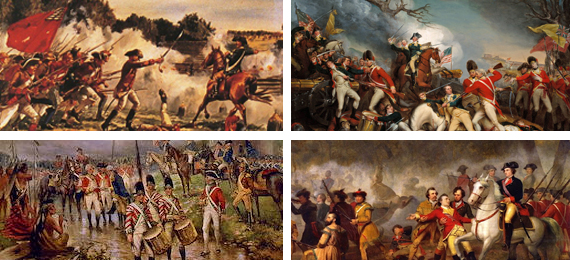
The Revolutionary war was initiated for American Independence from Britain. The Revolutionary war began with the battle of Lexington and Concord in 1775 and officially ended with the Treaty of Paris in 1783. The Revolutionary War officially began with exchanged gunshots called “the shot heard round the world” at Lexington and Concord in Massachusetts. The war involves campaigns and battles that lead to its victory. In this article you will learn more about the significance of the battle of Saratoga.
List of Few Important Battles
1) Lexington and Concord in April 1775
2) Bunker Hill in June 1775
1. Lexington and Concord War Occured in April 1785.
- A. True
- B. False
3) Invasion of Quebec in 1775
4) Saratoga in 1777
5) Philadelphia in 1777
6) Rhode Island in 1778
7) Cowpens in January 1781
8) Yorktown in October 1781
What Battle Was the Turning Point of the American Revolution?
Out of all these battles, Saratoga is considered the turning point of The Revolutionary War. The battle occurred in September and October of 1777. It is known as one of the most decisive battles in history. The British planned to put an end to the Revolutionary War by controlling upstate New York and isolating New England from the Southern colonies.
There were three troops British joining the battle. The troop led by General John Burgoyne planned to drive south from Montreal to Albany, New York alongside the route of Lake Champlain, Lake George, and the Hudson River. Once they reach Albany, the other two forces, one marching north from New York City and the other marching east from Lake Ontario combine with the troop led by General John Burgoyne.
Burgoyne and his troops started his journey from the Province of Quebec in June 1777. Burgoyne’s troops faltered near the forests around Lake George. In order to block Burgoyne’s path, colonists troops were felling trees. This made the troops slow down and by the time they reached Fort Edward, they were running out of supplies. Near Vermont, detachments were sent to procure cattle and supplies, in order to dwindle Burgoyne’s troops. The Burgoyne is now surrounded by American troops.
The troops that were coming from New York City by sea were led by General Howe. Under his order, they were asked to take up another route to capture Philadelphia but Washington’s continental army retreated to York. This prevented Howe from joining troops with Burgoyne. Here on the other side, Burgoyne cannot get out of the trap of the American forces, therefore he surrendered his army on October 17. Though France had already been helping by providing supplies, his act of surrendering brought France into the war as an American Ally. Burgoyne’s plan of New England from the southern colonies failed terribly due to logistical problems.
Near Saratoga, on a farm of Loyalist John Freeman, the first battle of Saratoga or the Battle of Freeman’s Farm began on September 19, 1777. On October 7, the second battle also known as the Battle of Bemis Heights occurred.
Who won the battle of Saratoga? The Burgoyne’s never received enough reinforcements. The cut-off in the troops and delayed actions became major advantages for the continental army to win. Why was the battle of Saratoga historically significant? The win over this battle was considered the turning point in American Revolution because it made the continental army believe in themselves and boosted their confidence to win the Revolutionary War.
You can visit Saratoga Monument in Saratoga National Park in order to know the key players of war.